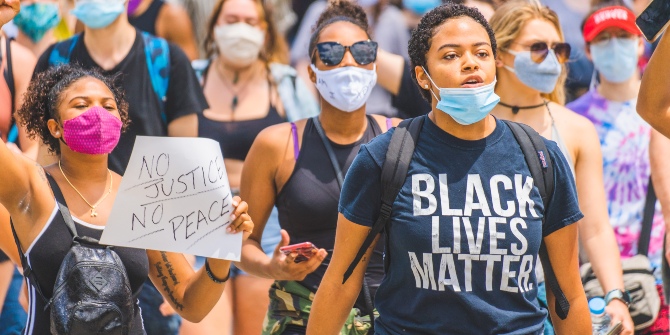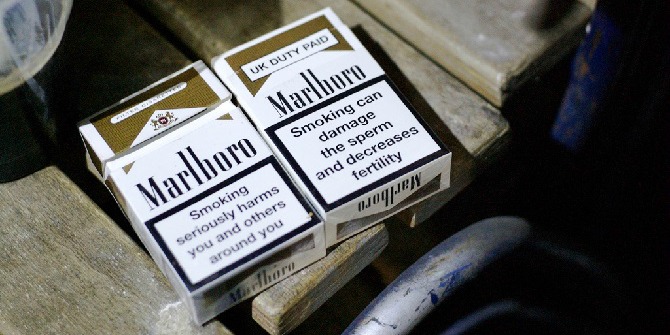 Past research has shown that when Republicans are afraid for their safety, or when they are concerned about gun laws being tightened, they buy more guns. In new research which uses background checks as a stand-in for gun sales, Matthew Lang determines that there have been eight million ‘extra’ gun sales in both Republican and Democratic states in 2020 compared to previous years. Using Google Trends data, he finds that this surge in gun buying is likely to be linked to many Americans’ growing fears about their personal safety.
Past research has shown that when Republicans are afraid for their safety, or when they are concerned about gun laws being tightened, they buy more guns. In new research which uses background checks as a stand-in for gun sales, Matthew Lang determines that there have been eight million ‘extra’ gun sales in both Republican and Democratic states in 2020 compared to previous years. Using Google Trends data, he finds that this surge in gun buying is likely to be linked to many Americans’ growing fears about their personal safety.
In the US, most firearm sales require a background check. Across the month of March 2020, as the COVID-19 pandemic became serious, a record 3.7 million firearm background checks were made. The record was short lived and in June 2020, a month filled with protests following the police killing of George Floyd, 3.9 million background checks were completed. Background checks have remained at historically high levels throughout the summer and into fall. A unique feature of the current surge in gun sales is that it is non-partisan. The increase in firearm background checks has not been significantly different between Republican-leaning and Democrat-leaning states.
Surges in gun sales have historically occurred after mass shootings and during elections, when concerns about future gun policy are heightened. A common feature of previous record-setting gun-buying events is that they are partisan, with Republican-leaning states having significantly more gun sales than Democrat-leaning ones. This has not been the case this year. In new research, we used Google Trends data to investigate the motivation for gun purchases and show that personal safety concerns, not gun policy uncertainty, are driving the non-partisan increase in firearm sales in 2020.
Firearm Background Check Surges
Since November 1998, the FBI has required all firearm purchases through licensed dealers to go through a background check that typically takes two minutes. Although the background checks do not cover all firearms sold in the US, they have been used frequently in past research to estimate the flow of new firearms into a state.
Using data from 1999 to 2019, we used a simple regression technique to predict the number of firearm background checks in every month. Figure 1 below shows how much firearm background checks deviated from expectations for every month from January 2012 to September 2020. The states are grouped by political affiliation, with states that were won by the Republican presidential nominee in three of the last five elections defined as Republican-leaning and captured in Red.
Figure 1 – Firearm background checks in Republican and Democratic presidential voting states

We can see that a number of gun-buying events in Figure 1; the Sandy Hook shooting in 2012 and the San Bernardino shooting in 2015 were both followed by a spike in firearm background checks in both Republican- and Democrat-leaning states. However, the spike in Republican-leaning states was significantly greater than Democrat-leaning states.

“Guns etc.” by Kevin Dooley is licensed under CC BY 2.0
The recent record-setting spike in firearms starting in March 2020 is non-partisan; the deviation from expectations between Republican- and Democrat-leaning states is statistically indistinguishable from March to June. Deviations in background checks in both groups have decreased since June, but remain elevated compared to expectations. Past events that led to gun sales were relative short-lived, with background checks returning to their expected levels within a month or two of the event. The spike in background checks that began in March 2020 has persisted throughout the summer and into fall. In the seven months since the onset of the COVID-19 pandemic, there have been eight million additional background checks completed relative to what was expected.
Why Do People Purchase Firearms?
The divisive nature of gun policy has made understanding firearm purchases historically difficult. Protection is the most common reason for owning a firearm according to both the 2015 National Firearms Survey and the 1994 National Survey on the Private Ownership of Firearms, but gun-buying events typically involve an increase in gun policy uncertainty. In order to explore the motivation behind past spikes in firearm sales, we utilized data from Google Trends which tracks search terms over time.
Figure 2 below shows how the search terms, “gun for home” and “gun policy” have changed since 2007. The term “gun for home” is meant to represent interest in purchasing a gun for home protection and safety. The term “gun policy” captures possible concerns about the future of gun policy. The month with the highest number of searches is normalized to a value of 100 and the rest of the values are relative to that month. We chose these terms because the actual amount of searches for the terms are similar, allowing them to be directly compared, but search terms such as “gun for protection” and “gun control” yield the same conclusions. The graph shows the two-month moving average for the search terms and “gun for home” is at its highest value (80.5) in July 2020 since it has a value of 100 in June and 61 in July.
Figure 2 – Google trends data for searches related to gun purchases and gun policy

We can see a number of gun-buying events in the figure above, and the spikes in search terms during these events provide insight about the motivation for buying firearms. During the 2008 Obama election, searches for gun policy spiked, but gun for home did not. This suggests that the motivation for purchasing firearms during this time was driven by gun policy uncertainty as opposed to safety concerns. A similar pattern emerges following the Parkland shooting in February 2018 and El Paso shooting in August 2019. In all of these events we observe a significant increase in background checks in Republican-leaning, but not Democrat-leaning states.
In December 2012 and December 2015, the months of the Sandy Hook and San Bernardino shootings, respectively, searches for both gun for home and gun policy spiked. This suggests that firearm purchases in the wake of these events were motivated by both gun policy uncertainty and safety concerns. In our analysis, we find that firearm background checks increased in both Republican- and Democrat-leaning states, but the increase was significantly greater in Republican-leaning states.
Searches for gun for home increased noticeably in March 2020 and then again in June. Over this time period, there was minimal change in the amount of searches for gun policy. This finding suggests that gun purchases starting in March 2020 are largely driven by concerns about personal health and safety, not gun policy uncertainty. Since March, firearm background checks have increased in both Republican- and Democrat-leaning states by a similar amount. The only other time we document a non-partisan spike in background checks is following the September 11th terrorist attacks, another event that presumably increased concerns and safety, but not gun policy.
The Future of Firearms
Prior to 2020, the majority of record-setting gun-buying events in the past have been associated with increased uncertainty about gun policy and been driven by Republican-leaning states. This is consistent with survey results showing that the majority of Republicans are opposed to stricter gun laws. The firearm surge in 2020 is motivated by increasing concerns about health and safety, but not gun policy uncertainty. The non-partisan increase in firearms since March suggests that individuals on both sides of the political spectrum value owning a firearm for safety reasons.
Policy makers may welcome the idea that Republicans and Democrats both value owning firearms, but the large increase in firearms is potentially concerning for public health officials. Firearms have been associated with higher rates of suicide, accidental firearm deaths, mass shootings and crime. The surge in firearms is happening during an unprecedented pandemic that may lead to a “perfect storm” of negative health outcomes. Policy makers should explore ways to reduce these negative outcomes. Adding inconvenience to the firearm purchasing process will not be popular, but saving additional lives during the COVID-19 pandemic is arguably worth the cost.
Please read our comments policy before commenting.
Note: This article gives the views of the author, and not the position of USApp– American Politics and Policy, nor of the London School of Economics.
Shortened URL for this post: https://bit.ly/2H5X9EO
 Matthew Lang – University of California, Riverside
Matthew Lang – University of California, Riverside
Matthew Lang is an Associate Professor of Teaching in the Department of Economics at the University of California, Riverside.







Well this time is very hard
Policy makers may welcome the idea that Republicans and Democrats both value owning firearms, but the large increase in firearms is potentially concerning for public health officials